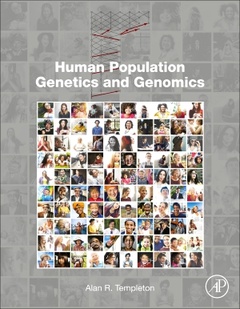Human Population Genetics and Genomics
Auteur : Templeton Alan R.

Human Population Genetics and Genomics provides researchers/students with knowledge on population genetics and relevant statistical approaches to help them become more effective users of modern genetic, genomic and statistical tools. In-depth chapters offer thorough discussions of systems of mating, genetic drift, gene flow and subdivided populations, human population history, genotype and phenotype, detecting selection, units and targets of natural selection, adaptation to temporally and spatially variable environments, selection in age-structured populations, and genomics and society. As human genetics and genomics research often employs tools and approaches derived from population genetics, this book helps users understand the basic principles of these tools.
In addition, studies often employ statistical approaches and analysis, so an understanding of basic statistical theory is also needed.
1. Definition, Scope and Premises of Human Population Genetics2. The Human Genome3. Systems of Mating4. Genetic Drift5. A Backwards View of Genetic Drift: Coalescence6. Gene Flow and Subdivided Populations7. Human Population History Over the Last Two Million Years8. Genotype and Phenotype9. Natural Selection10. Detecting Selection Through its Interactions with other Evolutionary Forces11. Units and Targets of Natural Selection12. Human Adaptations to Temporally and Spatially Variable Environments13. Selection in Age-Structured Populations14. Human Population Genetics/Genomics and Society
He is a Fellow of the American Association for the Advancement of Science, a recipient of the David Murdock-Dole Award for outstanding contributions in human genetic studies, a recipient of the Burroughs-Wellcome Fund Innovation Award in Functional Genomics, and a Fellow of the American Academy of Arts and Sciences. He has repeatedly been listed as an author of one of the top 1% most highly cited papers in the Life Sciences worldwide. He applies genomics and statistical population genetics to a variety of basic and applied problems on the genetics of complex diseases, evolutionary biology, human evolution, bioinformatics, and conservation biology.
- Comprehensively explains the use of population genetics and genomics in medical applications and research
- Discusses the relevance of population genetics and genomics to major social issues, including race and the dangers of modern eugenics proposals
- Provides an overview of how population genetics and genomics helps us understand where we came from as a species and how we evolved into who we are now
Date de parution : 11-2018
Ouvrage de 498 p.
19x23.3 cm
Mots-clés :
Adaptation; Adaptive landscape; Additive variance; Admixture mapping; Admixture; Age structure; Altruism; AMOVA; Ancient DNA; Antagonistic pleiotropy; Approximate Bayesian computation; Assortative mating; Average effect; Average excess; Background selection; Balanced polymorphism; Balancing selection; Bayesian statistics; Bottleneck effect; Cancer; Candidate gene; Chromosome; Clonal selection; Coadaptation; Coalescence time; Coalescence; Coevolution; Demographic transition; Disassortative mating; Disease; Ecotone; End of evolution; Environmental grain; Environmental heterogeneity; Epigenomes; Epistasis; Eugenics; Evolution; Evolutionary medicine; Exome; Family selection; Fertility; Fine-grained heterogeneity; Fitness; Founder effect; Frequency-dependent selection; Fundamental theorem of natural selection; Gene conversion; Gene flow; Gene pool; Gene tree; Gene-by-environment interaction; Genetic assimilation; Genetic cline; Genetic determinism; Genetic distance; Genetic drift; Genetic surfing; Genome; Genotype; Gradient; GWAS; Haplotype network; Haplotype tree; Haplotype; Hardy–Weinberg; Heritability; Heteroplasmy; Hitch-hiking; HIV; Human accelerated regions; Identity by descent; Imputation; Inbreeding depression; Inbreeding effective size; Inbreeding; Infinite-sites model; Intersexual competition; Isolation by distance; Isolation by resistance; Kin selection; Kin structured migration; Lactase persistence; Life history; Lineage sorting; Linkage disequilibrium; Local adaptation; Malthusian parameter; Maternal–fetal incompatibility; Mating success; Maximum likelihood; McDonald–Kreitman test; Meiotic drive; Missing heritability; Mitochondrial DNA (mtDNA)Mutation; Mother's curse; Multiregional model; Mutation; Mutational load; Natural selection; Negative selection; Neighborhood size; Nested clade analysis; Net reproductive rate; Neutral evolution; Niche construction; Out-of-Africa replacement; Parsimony; Peto's paradox



